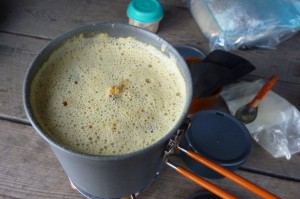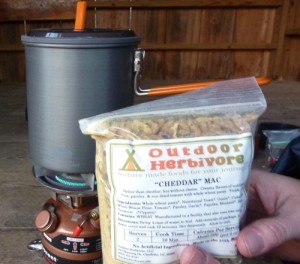White gas, kerosene, isobutane, and denatured alcohols are standard fuels used with backpacking stoves. Fuel savings greatly depend on the efficiency of the cooking process, as well as the stove and cooking pot. One of the most effective ways to conserve fuel is to minimize energy loss during cooking. You don’t want to run out of fuel mid-hike and be left eating cold freeze-dried entrées. Here are a few strategies to conserve stove fuel.
No flame in vain
 Only allow the fuel to burn when it is in use, such as when heating your food.
Only allow the fuel to burn when it is in use, such as when heating your food.
Before preparing food, collect all your camp kitchen equipment—stove, fuel, cook pot, utensils, lighter, meal, and water— and keep it all within arm’s reach. Open the package and have everything ready before bringing your water to a boil. You don’t want the stove burning off precious fuel while you try to locate your foodstuff, or fidget trying to open the packaging.
- Light up your stove after adding the necessary ingredients to the cooking pot, such as water. If you don’t need to add the ingredients right away, at least ensure the packaging is opened.
 Use an optimal amount of water
Use an optimal amount of water
Only use as much water as you need. The more water, the more fuel is required to bring it to a boiling point. Never drain off any surplus cooking water; find a use for it or drink it later, rather than lose the precious nutrients. If the entrée is too soupy, grab some bread to soak up the excess liquid.
- Cooking Pasta: Use 1.5 times of water per measurement of pasta to allow for proper absorption.
- Other Instant Grains (Rice, Quinoa, Oats, Polenta, Lentil): 1 to 1 ratio of water to instant grain for proper absorption.
Pasta cooking tip: Cooking whole wheat dry pasta will take a few minutes longer than the processed instant variety. When cooking dry pasta follow the boil-soak method. In other words, bring a covered pot of water to a boil, stir in the pasta, turn off the stove, and allow the residual heat to finish cooking the pasta. It will take about 8-10 minutes for whole-wheat pasta to cook al dente. If you insulate the pot, you can shave off another minute or so during the soak time.
When you cook pasta this way, always use less water than the package recommends and retain any excess cooking water! The pasta water has starch (calories) that you do not want to waste. If you are making something else, use the extra pasta water for the sauce, potato flakes, hot cocoa, soup, etc. Heat and air decrease the amount of soluble vitamin content in prepared food, which means dehydrating foods depletes vitamin content, cooking depletes vitamin content, and further losses occur if you discard the cooking water. Don’t do it!
Use a tight-fitting lid
The most important step you can take to reduce fuel consumption on the trail is to use a lid. Ensure the lid fits tight enough to keep the water vapor sealed inside. By covering the pot with a lid, the energy contained in the steam is utilized and transferred to cook the food, rather than being lost through evaporation. In fact, using a lid can conserve as much as 40% of your fuel. The fuel savings are even greater if the wind is blowing..
Use the proper size cook pot
The contact the cooking pot makes with the flame is very important when it comes to fuel conservation. The best gains in fuel efficiency come from the size of the pot itself and its ability to transfer the heat without obstruction. The flame under the cooking pot should make direct contact with the pot without the flame spilling over the edge. Any excess flame that travels up the side of the pot is lost to the atmosphere, which is wasted fuel.
Most backpacking stoves tend to have small burners, so picking a pot that is too small for the burner is normally not an issue. Broad bottomed, shallow cooking pots tend to be the most energy efficient. Tall and narrow cooking pots tend to be less efficient, especially if the flame creeps up the side of the pot. If this happens, reduce the flame to low in order to save on fuel.
Decrease or eliminate the flame once water starts boiling
Once the water has reached a boiling point, turn down the flame or shut off the fuel. Boiling water will never exceed boiling temperature (roughly 212°F or 100°C based on atmospheric pressure & salts). Once water reaches the boiling point, it will remain at that temperature until all the water has boiled off or evaporated. While a big flame will bring the water to boil faster, a lower flame will use less fuel even though it takes more time to bring the water to a boil. Experiments demonstrate that the additional time to achieve a boiling point at a lower flame consumes less fuel than a faster boil time at a higher flame. Decide if your time or fuel is more valuable to you.
Clean the stove burner
Liquid-fuel backpacking stoves require regular cleaning and maintenance. Over time, carbon and soot can accumulate around the burning mechanism, leading to increased fuel consumption. To check for efficient operation, look for a bright, steady blue flame. A non-uniform, yellowish flame typically indicates that the burner is clogged and needs cleaning.
Soak ingredients before cooking
As mentioned in our previous post, soaking food ingredients, such as pasta, lentils, and rice, before cooking and following the boil-soak method saves even more on stove fuel.
All these fuel savings strategies will provide significant savings in terms of pack weight, money, and the environment.
 Use an optimal amount of water
Use an optimal amount of water

4 thoughts on “Cooking to Save Fuel”
nice…
All good tips, Thanks!
Heres another tip. Always cook behind a natural or human made windbreak. A log, a stack of rocks, your pack or a tarp. The wind blows alot of heat away even at a gentle breeze.
Great post. I always wondered wether the low heat method was more efficient.